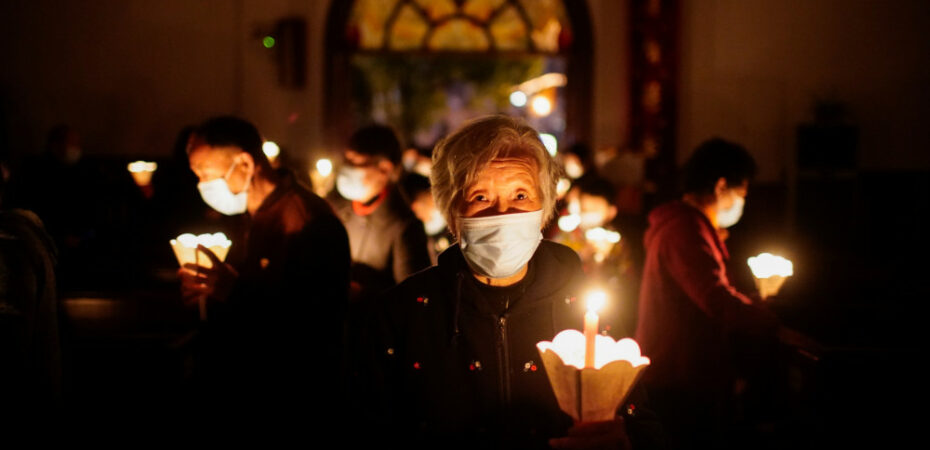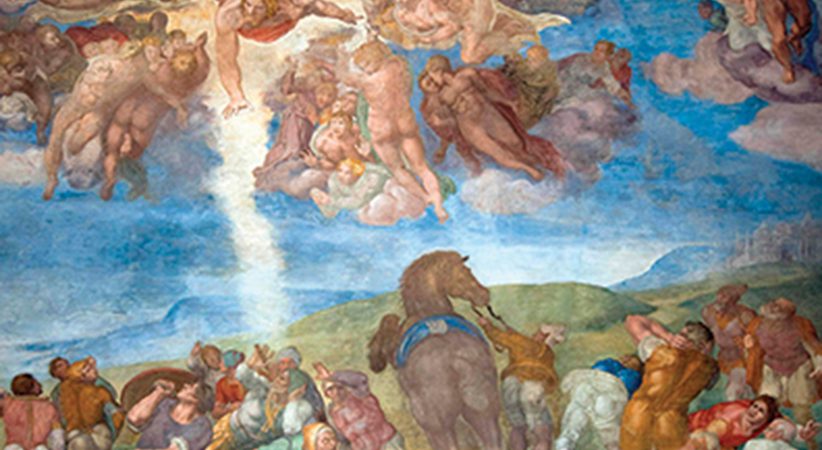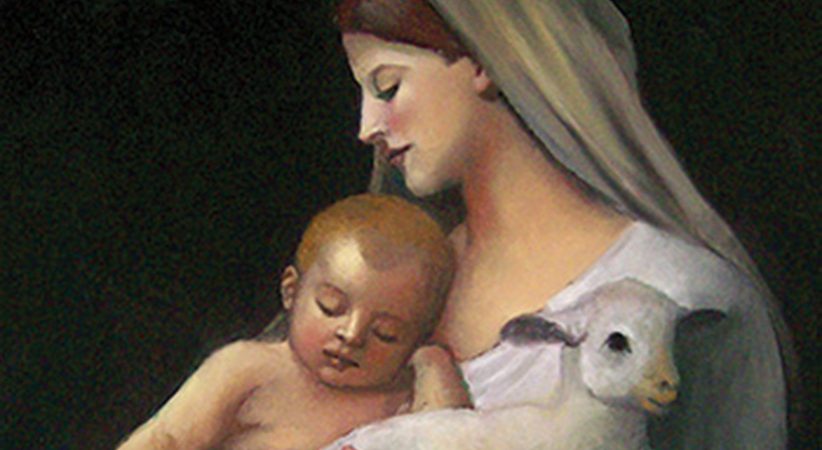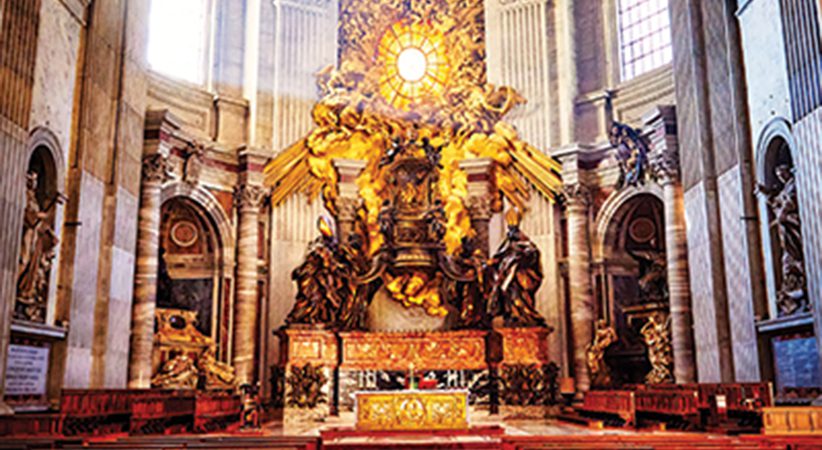‘This Is the Night’
Embracing the significance of the Easter Proclamation
Father Paul Turner Comments Off on ‘This Is the Night’
Christianity stares at death and sees life. The Easter Vigil brings worshipers into the heart of this paradox. When tears should signal an impulsive reaction to death, a lone singer stands athwart the community with a counterintuitive message shortly after it observed the crucifixion of Jesus: “Rejoice!” The Easter Proclamation summons angel hosts, the earth and Mother Church to exult at the triumph of Christ the King. The chant is better known by its traditional Latin title, the Exsultet.
One iconic phrase recurs five times: “This is the night.” In English, the difference between “night” and “light” is a single letter. The paradox rings even in the ear. This night, unlike any other, is pure light. It recalls Psalm 139:12, which considers the impossibility of hiding from God in the dark: “even darkness is not dark to you, / the night shall be as bright as day, / and darkness the same as the light” (Abbey Psalms and Canticles).
The pronoun “this” presents another paradox. Believers have gathered because of something that happened in the past, but the Exsultet proclaims that it is happening in the present. It transports the community from this time and place to the eternally mystical moment of Jesus’ resurrection from the grave.
The Exsultet is a long prayer of petition, ultimately asking God to accept the paschal candle as an evening sacrifice of praise and to let it persevere, shining its light into an eternal day. This one candle spreads its light as the community spreads its faith.
Before making those requests, the Exsultet catechizes those who hear it, giving them reasons to rejoice. It frames these by calling the moment “the feasts of Passover.” The Christian Passover fulfills the Jewish Passover. The power of both feasts reverberates through this night. As the blood of the lamb dabbed on doorposts saved the children of Israel from God’s avenging angel, so the blood of Christ protects believers from death.
The Five Proclamations
The first proclamation that “This is the night” steps directly into the first Passover. After eating lamb, the children of Israel began their exodus at the Red Sea. They passed through its waters, paradoxically, dry-shod, because of the power of God, who turned waves into walls to guarantee safe passage. The Exsultet calls “Israel’s children” “our forebears.” The paradox continues: children are parents.
The second proclamation that “This is the night” refers to the pillar of fire that guided Israel to its Promised Land. On the journey, Israel followed a pillar of cloud by day and a pillar of fire by night. When the Exsultet says that this night “banished the darkness of sin,” it stirs reflections on both Passovers. The pillar let Israel progress apace even at night, well ahead of evil enemies. It put the darkness of sin behind them: the enslavement of oppressors and the despair of the oppressed. Among Christians, the paschal candle signifies the light of Christ, whose message guides those who turn from sin toward saving forgiveness. The paschal candle has been a pillar of fire, leading the community from outside the church into the promised land of sacred space while all acclaim the light of Christ.
………………………………………………………………………………………………………………………………………………………….
THE EXSULTET: CHRIST OUR LIGHT
“As the Exsultet exhorts us, ‘Be glad, let earth be glad, as glory floods her, ablaze with light from her eternal King, let all corners of the earth be glad, knowing an end to gloom and darkness.’ May this venerable Easter Proclamation serve us and our assemblies as a genuine expression of Easter hope and joy.”
— Father Michael J. Flynn, USCCB website
…………………………………………………………………………………………………………………………………………………………..
The third proclamation that “This is the night” leaves behind the Jewish Passover to describe the Christian Passover. On this night, throughout the world, baptism leads believers from sin to grace and joins them to God’s holy ones.
The fourth proclamation that “This is the night” declares that Christ has broken free from the prison of death and has risen from the underworld. The Apostles’ Creed professes that Christ descended into “hell,” to which the Exsultet refers. Through his death, Christ entered the underworld — not the hell of the damned, but the place of those awaiting redemption, including the forebears who experienced the Exodus from Egypt. The Resurrection has unlocked the prison of death, and Christ leads the way, paradoxically, from death to life.
Here, the fivefold litany pauses to reflect on this mystery. Being born human is no gain of itself. Creation yearns for redemption. The death of Christ has undone the sin of Adam. Adam’s culpability was therefore happy because it secured the needed redeemer. Without sin, humans would not have known grace. The Exsultet bestows its most renowned paradox here: felix culpa. “O happy fault!” The action that should have brought punishment led to salvation. Of all the nights of history, this one is blessed because it alone knew the hour when Christ rose from the dead.
The fifth proclamation that “This is the night” turns the attention of the community to the purpose of its gathering: This Easter Vigil turns night into day. The light that spreads inside the church reveals the sanctifying power that “dispels wickedness, washes faults way, / restores innocence to the fallen, and joy to mourners, / drives out hatred, fosters concord, and brings down the mighty.” This lighted night changes history.
Having proclaimed why “This is the night,” the Exsultet makes its requests that the Father accept the candle and let its light persevere.
Applications
The Exsultet expresses the central belief of Christianity and enlivens faith. The message will resound all the more with attention to some details.
Candlelight. The paschal candle is to be made of wax and renewed each year (cf. Congregation for Divine Worship, “Circular Letter Concerning Preparation and Celebration of Easter Feasts,” No. 82). Even if the parish has plenty of inches left on last year’s candle, it should be retired for devotional purposes in a more private space for prayer. The newness and height of the candle express the bright message of the Exsultet. The wax candle sacrifices itself to proclaim its message of light in the darkness, life in the face of death.
Electric lights. The most overlooked rubric in the Roman Missal’s presentation of the Easter Vigil may be the following: When the paschal candle is placed on its stand near the ambo or in the middle of the sanctuary, and before the beginning of the Exsultet, the rubric states, “And lights are lit throughout the church, except for the altar candles” (No. 17).
Those are the electric lights. Many parishes have the Exsultet sung completely by candlelight. Sometimes they even proclaim the Old Testament readings by candlelight. But the rubrics envision something else. The light of Christ is so strong that it sets the electric lights ablaze as well. Light completely floods the church before the Exsultet begins so that its paradoxical message rings out in full force. This candle, this light of Christ, has brought full brightness to the church in the middle of this holy night.
Attendance. Many Catholics irresponsibly avoid the Easter Vigil because it’s too long, it focuses on catechumens whom they’ve never met, and they prefer a different tradition of worshiping on Easter Sunday morning. Some who attend the Easter Vigil for the first time mistakenly wonder if it fulfills their obligation to attend Easter Sunday Mass.
The Easter Vigil is the mother of all the Church’s vigils and liturgies. The Exsultet explains why, but few Catholics ever hear it. At a time when the bishops of the United States are inviting all Catholics to enter a three-year Eucharistic Revival, an appropriate start would be with the Easter Vigil. At every Mass, Catholics receive the Body and Blood of the Risen Christ. At every Easter Vigil, Catholics gather for their earliest communion with the Risen Christ in Easter time.
Singer. Traditionally, a deacon sings the Exsultet, which shows its connection to the Gospel of the Resurrection, which he will proclaim at the ambo. At the beginning of the vigil, the deacon approaches the same ambo to proclaim the effects of the Resurrection. However, the music is complex, and the rubrics now wisely permit someone else to sing. The message is so strong, so joyful, so transforming, that a skilled, faith-filled, joyful singer will best communicate it to the people. The deacon may yield to someone else. The community deserves to hear the Exsultet sung well.
Spelling. This is not a huge issue, but the correct spelling of Exsultet includes the letter “s.” A different word, “exalt,” means “to praise,” and it comes from Latin words referring to something on high. But “exult” comes from the Latin words referring to jumping, which entered French and English to describe cooking with oil in a stovetop pan: sauté. The word “Exsultet” clues the singer to jump for joy, not to fear missing the next note.
Faith. The message that “This is the night” aims to enter the bones of believers. When the Exsultet asks the Father to let the light of this candle persevere until dawn, it means until the eternal dawn. The paradoxical message of light in the darkness is to resonate with believers into every new day until the end of time. Everyone faces what the fifth proclamation identifies: “wickedness,” “faults,” being “fallen,” “mourners,” “hatred” and “mighty” opponents. Fronting such opposition, humans impulsively react with worry and tears. The Exsultet scatters these concerns. Despair is inexcusable. No darkness can obliterate the light of Christ. The dawn of each new day reminds Christians that night does not endure. They can stare at death and see life. Even when Christians experience what feels like an unending night, the Exsultet gives them strength. “This is the night” in which Christ redeems. It is “bright as day, dazzling … and full of gladness.”
FATHER PAUL TURNER is pastor of the Cathedral of the Immaculate Conception in the Diocese of Kansas City-St. Joseph. He is the author of “Glory in the Cross: Holy Week in the Third Edition of the Roman Missal” (Liturgical Press, $24.95).
…………………………………………………………………………………………………………………………………………………………..
Singing Full of Joy
“Thus we can sing full of joy, together with the Church, in the words of the Exsultet: ‘Sing, choirs of angels … rejoice, O earth!’ The Resurrection is a cosmic event, which includes heaven and earth and links them together. In the words of the Exsultet once again, we can proclaim: ‘Christ … who came back from the dead and shed his peaceful light on all mankind, your Son who lives and reigns for ever and ever.’ Amen!”
— Pope Benedict XVI, Homily at the Easter Vigil, April 15, 2006
…………………………………………………………………………………………………………………………………………………………..





